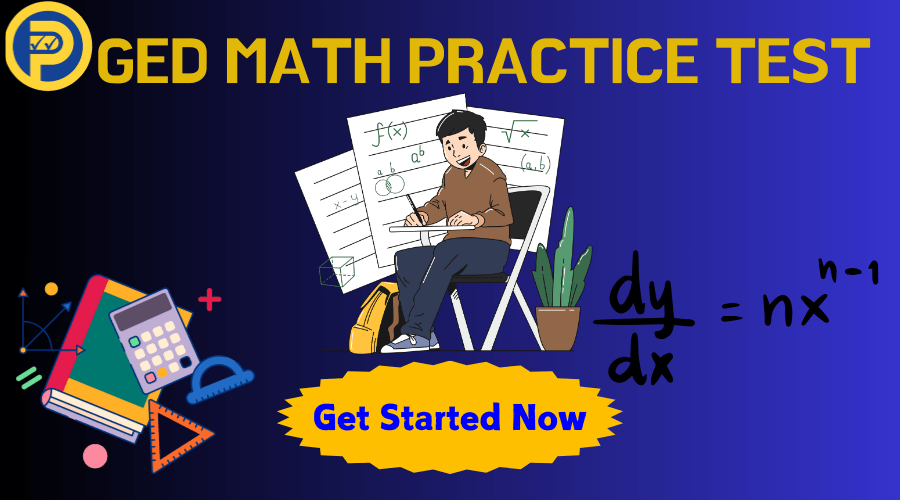Do you want to identify the GED math topics that demand the most of your study time? Prepsaret GED Math Practice Test provides questions with answers and explanations to help you identify your strengths and weaknesses, so you can focus on the areas that need the most improvement.
To help you identify areas that require improvement, we offer 10 comprehensive math practice tests, comprising 200 questions. This allows you to focus on specific topics that need refinement, saving you time by avoiding repetition of already mastered topics and concepts.
Importance of the GED Math Practice Test
Provides Regular Math Practice
The key to success is to work through as many practice questions as possible. This hands-on experience will help you become familiar with the exam format, question types, and the skills required to solve them.
Better Understanding of the Concepts
After attempting each practice question, review the provided correct answer along with a detailed explanation. This step is crucial, as it allows you to understand the underlying concepts and problem-solving strategies. By thoroughly comprehending the solutions, you’ll be better equipped to tackle similar questions on the actual exam.
Identify and Address Weaknesses
As you work through the practice questions, pay close attention to the areas where you struggle. Use this feedback to pinpoint your weaknesses and focus your study efforts on those specific topics or skills. This targeted approach will help you strengthen your overall math proficiency.
Develop Confidence and Fluency
Consistent practice with detailed feedback will not only improve your math skills but also boost your confidence.
The more practice questions you complete, the more comfortable and fluent you’ll become in applying the necessary concepts and techniques to solve GED Math problems.
Remember, the GED Math exam is designed to assess your mathematical reasoning and problem-solving abilities. By dedicating time to thorough practice and understanding the solutions, you’ll be well on your way to achieving your GED goals.
Type of questions covered in the GED Math Practice Test
Basic Math
Prepsaret GED math practice tests include basic math questions that assess your proficiency in addition, subtraction, multiplication, and division using a calculator.
You’ll be tested on your ability to work with fractions, decimals, percentages, roots, and exponents. Word problems are also a crucial part of the test, requiring you to translate real-world scenarios into mathematical expressions and solve them accurately.
Geometry
Geometry questions in GED math practice tests require a solid understanding of formulas relating to shapes and objects.
Test-takers are often presented with drawings of shapes and must apply provided formulas to calculate various properties such as surface area, volume, radius, diameter, and more.
For example, they may need to use the formula for the area of a circle (A=pi r^2) to find the area of a circle given its radius.
Similarly, they may use the formula for the volume of a cylinder (V=pi r^2 h) to find the volume of a cylinder given its radius and height. Accurate calculations require attention to detail and a thorough understanding of geometric formulas.
Algebra
Algebra questions assess your ability to solve equations and write formulas based on word problems. You are expected to determine the value of a variable in an equation by isolating it and performing necessary operations.
Additionally, you should be able to write a formula with a variable in it by identifying the relationship between the variables and constants given in the problem.
For example, if a word problem states that the cost of a product is $5 plus $2 per unit, you would write the formula as C = 5 + 2u, where C is the cost and u is the number of units.
Graphs and Functions
Prepsaret GED math practice tests often include questions that assess your ability to read, analyze, and interpret information presented in graphs, charts, and tables. These questions may cover topics such as median, mean, mode, range, probability, and statistics.
To succeed in these questions, you need to be able to understand how data is organized and presented, and to extract relevant information from the visual representations.
This includes understanding common graph types, identifying trends and patterns, and making inferences based on the data. Mastering these skills will help you demonstrate your mathematical reasoning and problem-solving abilities on the GED exam.
Sample Math Practice Question
Question:
A house cleaning company owner, Alex, needs to give price quotes to customers. He calculates his price by adding a base charge of $30 and then adding $10 for each bathroom and $5 for each other room. If he uses P to represent the price, B for bathrooms, and R for other rooms, which of the following represents his price quote formula?
Here are the multiple choices for the question:
Choices:
- P = 30 + 12(BR)
- P = 30 + 10B + 5R
- P = 30(5R + 10B)
- P = (5)(10)(R + B) + 30
Solution:
To represent Alex’s price quote formula, we need to add the base charge of $30 and then add $10 for each bathroom and $5 for each other room.
Let P be the price, B be the number of bathrooms, and R be the number of other rooms. The correct formula is:
P = 30 + 10B + 5R
This formula adds the base charge of $30 and then adds $10 for each bathroom and $5 for each other room. The correct answer is option B.
Overview of the GED Math Test
The GED Math Test consists of 46 questions, divided into two parts. The first part includes five questions where calculators are not permitted, focusing on arithmetic competencies and basic number sense. This section assesses your foundational math skills.
The second part contains 41 questions, where calculators are allowed.
You can use the on-screen Texas Instruments TI-30XS calculator or bring your own TI-30XS if you take the test at a test center. Additionally, you will have access to important math formulas during this section.
Test Duration
The GED Math test allows test-takers 115 minutes to complete all questions. This duration provides sufficient time to thoroughly address the various math concepts and problem-solving strategies required for the test.
Both the non-calculator and calculator sections are untimed individually, allowing test-takers to allocate their 115-minute total time as they see fit. This flexibility enables test-takers to manage their time and approach the test in a way that suits their individual needs and strengths.
Questions Format
The GED math test features a variety of question formats to assess students’ mathematical skills. The majority of questions are multiple-choice, where students select the correct answer from a list of options.
Additionally, the test includes filling in the blank and dragging questions, where students must fill in missing values or drag the correct answer to the correct location. These formats help to ensure a comprehensive evaluation of mathematical understanding.
GED Math Formulas
The GED Math test provides a Formula Reference Sheet to assist test-takers in calculating answers without memorization. This sheet includes essential formulas for solving various mathematical problems.
Formulas are step-by-step procedures that help solve routine issues and problems in mathematics. They can be used to find specific information such as volume, area, perimeter, missing side lengths, averages, distances, and slopes.
These formulas are not only useful for solving problems on the GED Math test but also in everyday life. For instance, a formula for measuring the area of a rectangle can be used to determine how much paint is needed to cover a room’s walls.
Volume Formulas
When calculating the volume of a box or space, it is crucial to understand the volume formulas. The formula for volume is simple: multiply the length, width, and height of the box.
This calculation is essential for determining the capacity of a shipping box, which is typically labeled with its cubic inches or feet capacity.
Similarly, the volume of a cylindrical object is calculated using the formula V = πr²h, where V is the volume, π is approximately 3.14, r is the radius of the circular base, and h is the height.
This formula is used to find the volume of various types of cylinders, including right circular cylinders, oblique cylinders, elliptical cylinders, and hollow right circular cylinders.
Geometry Area Formulas
Geometry area formulas are essential for measuring the surface of a specific space. The area is typically described in square units and is calculated by multiplying the length and width of a shape.
For instance, a closet floor measuring 5 feet by 5 feet has an area of 25 square feet, calculated by multiplying 5 by 5. The GED Math test formula sheet includes formulas for finding the areas of various shapes, including squares, parallelograms, rectangles, trapezoids, and triangles.
Perimeter Formulas
The perimeter of a shape is the distance that encloses it. Formulas exist to calculate the perimeter of specific shapes, such as rectangles and squares. For instance, the perimeter of a rectangle is calculated by adding the lengths of all its sides: P = 2l + 2w.
Similarly, the perimeter of a square is P = 4s. Irregular shapes, on the other hand, require adding all sides to determine their perimeter. This approach ensures accurate measurements for various shapes.
How to Prepare for the GED Math Test
To prepare for the GED math test, it is crucial to develop a consistent study routine. Start by setting aside dedicated time each day for studying, ideally in a quiet and distraction-free environment.
Utilize online resources such as Prepsaret’s GED math practice test to gauge your understanding and identify areas that require improvement. These tests provide realistic simulations of the actual exam, allowing you to assess your strengths and weaknesses.
Another valuable resource is the GED Preparation Resources page, which offers essential information to aid in effective GED math preparation. This page can help you develop a personalized study plan and stay on track throughout your preparation journey.
Additionally, supplement your online practice with library books and other study materials to reinforce your knowledge.
By combining these resources with daily scheduled study sessions, you will be well-prepared to tackle the GED math test with confidence.
Learn how you can easily study for all your GED tests with our GED Study Guide.
Online GED Math Classes
In addition to GED Math Practice Tests, Prepsaret offers online GED math classes which provide a convenient and flexible solution for people seeking to prepare for the GED math exam.
These online classes cater to diverse learning styles and schedules, allowing students to study at their own pace. The engaging video lessons and live consultations cover the necessary subject areas, equipping students with the skills and confidence to excel on the GED exam.
By leveraging this flexible approach, students can effectively prepare for the GED math test while balancing other life commitments.
FAQs
What level of Math is on the GED Test?
The GED test includes math questions that cover various levels of difficulty, focusing on basic arithmetic operations, algebraic concepts, and geometric calculations.
The math section is divided into two parts: Mathematical Reasoning and Quantitative Reasoning. Mathematical Reasoning tests problem-solving skills, while Quantitative Reasoning assesses the ability to analyze and interpret data.
The math questions are designed to be relevant to everyday life, covering topics such as ratios, proportions, percentages, and basic algebra. The test does not require advanced calculus or trigonometry, but rather emphasizes practical applications of mathematical concepts.
How to Practice for the GED Math Test?
To practice for the GED Math test, start by familiarizing yourself with the test format and content areas, which cover arithmetic, algebra, geometry, and data analysis. Identify your strengths and weaknesses by taking practice tests and pinpoint areas that need more attention.
Utilize online resources and study guides, such as the one offered by Prepsaret to help you prepare. Practice regularly to improve your math skills and build confidence, and don’t hesitate to seek help from teachers, tutors, or online forums when needed.
Finally, manage your time effectively during the test by practicing pacing yourself to ensure you complete all questions.
Is Math Hard on the GED Test?
Yes, math can be challenging on the GED test. The test covers various math topics, including algebra, geometry, and data analysis. It requires a strong foundation in basic math concepts and problem-solving skills.
The test includes multiple-choice questions and a limited-response section, which can be time-consuming. To prepare, it is essential to review and practice math concepts regularly, focusing on problem-solving strategies and time management.
How long is the GED Ready Math Practice Test?
The GED Ready Math Practice Test is 45 minutes long. This test serves as a preparatory tool for the official GED Math test, helping candidates assess their readiness and identify areas needing improvement.
It closely mirrors the actual test in format and difficulty, providing a realistic practice experience. Completing this practice test can boost confidence and improve performance on the real exam.
What is the Hardest GED exam?
The hardest GED exam is often considered to be the Mathematical Reasoning test. This test assesses a candidate’s ability to apply mathematical concepts to real-world problems, including algebra, geometry, and data analysis.
It requires a strong foundation in basic math operations, as well as the ability to solve complex problems and interpret data. The test also includes questions on graphing, functions, and trigonometry, making it challenging for many test-takers.
Additionally, the time constraint of 115 minutes adds to the difficulty, as candidates must quickly and accurately solve a range of problems to achieve a passing score.
What Score do you need to Pass GED Math?
To pass the GED Math test, you need to score at least 145 out of 200 points. This is equivalent to 72.5% of the total score. The test consists of 46 multiple-choice questions and 2 open-ended questions, covering topics such as algebra, geometry, data analysis, and more.
To achieve a passing score, you must demonstrate a basic understanding of mathematical concepts and problem-solving skills.
Are Prepsaret GED Math Practice Tests Helpful?
Yes, Prepsaret GED Math Practice Tests are helpful. These tests provide a comprehensive review of the GED math curriculum, allowing students to assess their understanding and identify areas for improvement.
By practicing with these tests, students can build confidence in their math skills, develop problem-solving strategies, and become more comfortable with the format and timing of the actual GED exam.
Additionally, Prepsaret’s tests offer detailed explanations and solutions for each question, enabling students to learn from their mistakes and refine their knowledge. Overall, these practice tests are a valuable resource for students preparing for the GED math section.




